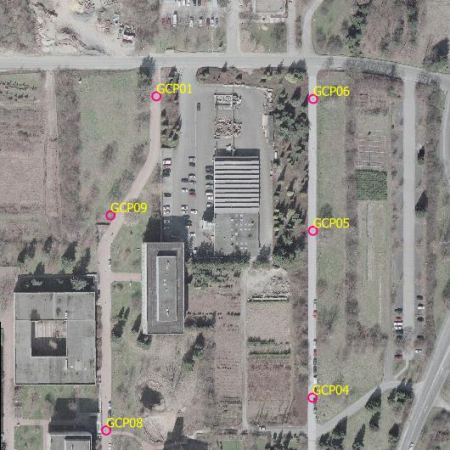Georeferencing (Tutorial)
From AWF-Wiki
(Difference between revisions)
| Line 2: | Line 2: | ||
:''This article is part of the [[QGIS tutorial 2013/14]].<br/>In this article you learn how to georeference a raster image.'' | :''This article is part of the [[QGIS tutorial 2013/14]].<br/>In this article you learn how to georeference a raster image.'' | ||
| − | # First, you need an image, e.g. an aerial photograph, that lacks spatial information. For exercise purposes, you can generate one from the [[Course data]] by opening the file ''aerial_utm_32_WGS84.tif'' from the ''geodata/raster/aerial/'' folder with an image processing program (e.g. Irfanview under Windows). Simply save the file under a different name, e.g. ''image_raw.tif'' and open it in [[QGIS]]. [[QGIS]] will issue a | + | # First, you need an image, e.g. an aerial photograph, that lacks spatial information. For exercise purposes, you can generate one from the [[Course data]] by opening the file ''aerial_utm_32_WGS84.tif'' from the ''geodata/raster/aerial/'' folder with an image processing program (e.g. Irfanview under Windows). Simply save the file under a different name, e.g. ''image_raw.tif'' and open it in [[QGIS]]. [[QGIS]] will issue a warning that the layer lacks spatial information, prompting you to select a coordinate system. You can pick one ad libitum, e.g. WGS84 (EPSG:4326) or Gauss-Kruger zone 3 (EPSG:31467), and confirm with {{button|text=OK}}. |
#* If you look at the coordinates under {{button|text=Coordinate}} below the [[QGIS GUI|canvas]] you will recognize that the coordinates are far off the real position of the map. The top left corner of the image is located at the coordinate systems point of origin (thus 0,0), which you can see by simply positioning the mouse cursor at the corner. | #* If you look at the coordinates under {{button|text=Coordinate}} below the [[QGIS GUI|canvas]] you will recognize that the coordinates are far off the real position of the map. The top left corner of the image is located at the coordinate systems point of origin (thus 0,0), which you can see by simply positioning the mouse cursor at the corner. | ||
# Open {{mitem|text=Raster --> Georeferencer --> Georeferencer}}. If the georeferencer is not available, you'll have to activete it first. Just open {{mitem|text=Plugins --> Manage and install plugins}} and type {{typed|text=georeferencer}} into the search bar. Check the box {{button|text=Georeferencer GDAL}} and close the window. The plugin should now be available. | # Open {{mitem|text=Raster --> Georeferencer --> Georeferencer}}. If the georeferencer is not available, you'll have to activete it first. Just open {{mitem|text=Plugins --> Manage and install plugins}} and type {{typed|text=georeferencer}} into the search bar. Check the box {{button|text=Georeferencer GDAL}} and close the window. The plugin should now be available. | ||
Revision as of 17:33, 9 December 2013
| sorry: |
This section is still under construction! This article was last modified on 12/9/2013. If you have comments please use the Discussion page or contribute to the article! |
- This article is part of the QGIS tutorial 2013/14.
In this article you learn how to georeference a raster image.
- First, you need an image, e.g. an aerial photograph, that lacks spatial information. For exercise purposes, you can generate one from the Course data by opening the file aerial_utm_32_WGS84.tif from the geodata/raster/aerial/ folder with an image processing program (e.g. Irfanview under Windows). Simply save the file under a different name, e.g. image_raw.tif and open it in QGIS. QGIS will issue a warning that the layer lacks spatial information, prompting you to select a coordinate system. You can pick one ad libitum, e.g. WGS84 (EPSG:4326) or Gauss-Kruger zone 3 (EPSG:31467), and confirm with OK.
- If you look at the coordinates under Coordinate below the canvas you will recognize that the coordinates are far off the real position of the map. The top left corner of the image is located at the coordinate systems point of origin (thus 0,0), which you can see by simply positioning the mouse cursor at the corner.
- Open Raster --> Georeferencer --> Georeferencer. If the georeferencer is not available, you'll have to activete it first. Just open Plugins --> Manage and install plugins and type georeferencer into the search bar. Check the box Georeferencer GDAL and close the window. The plugin should now be available.
- In the georeferencer dialogue, click the Add raster icon. Browse for the image and click through the CRS-warning dialogue as described above.
GCP No. Easting Northing Height 01 566399.97 5712572.95 225.07 04 566491.76 5712396.51 232.50 05 566490.18 5712492.46 224.70 06 566489.27 5712570.51 222.00 08 566369.05 5712371.58 214.59 09 566370.13 5712508.13 217.87
